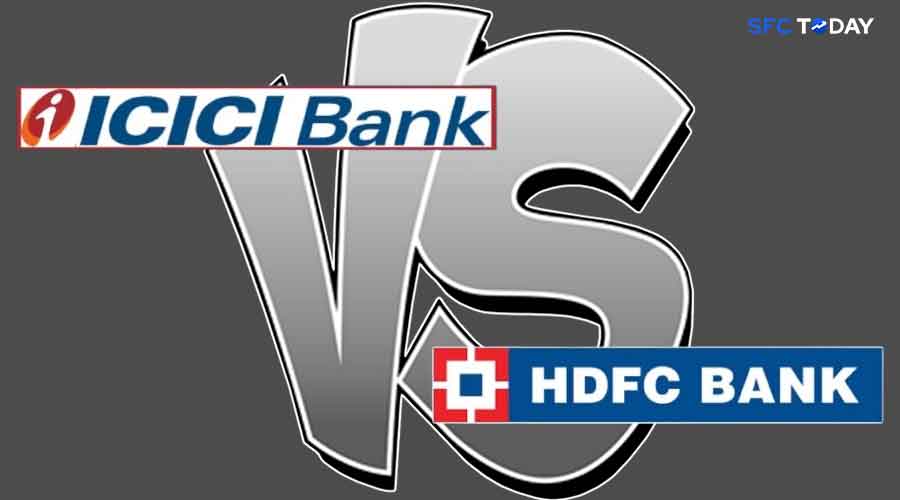Who dominated India’s private banking space this quarter? Dive into the full comparison now
In the fourth quarter of fiscal year 2025, ICICI Bank and HDFC Bank reported strong earnings, highlighting their dominance in India’s private banking sector. Their Q4 results reflect not only their operational strength but also their evolving strategies in a competitive financial landscape. Both banks delivered growth in profitability, loan book expansion, and asset quality improvement, but a closer comparison reveals which bank took the lead in this earnings season.
Net Profit Comparison
ICICI Bank posted a standalone net profit of ₹12,630 crore in Q4 FY25, registering a sharp 18% rise from the same quarter last year. The bank attributed this growth to strong loan demand, better asset quality, and an improvement in its core income streams.
In contrast, HDFC Bank reported a standalone net profit of ₹17,616 crore, representing a 6.7% increase year-on-year. The profit figure remains higher in absolute terms, but the growth rate fell short compared to ICICI Bank’s performance. HDFC Bank continued to benefit from its large-scale operations and diversified customer base, but integration-related costs and margin pressures weighed slightly on its bottom line.
ICICI Bank’s profit growth clearly outpaced HDFC Bank, showing more aggressive expansion and operational efficiency during the quarter.
Net Interest Income (NII) and Margins
ICICI Bank generated ₹21,193 crore in net interest income for Q4, marking an 11% increase year-on-year. The bank reported a robust net interest margin (NIM) of 4.41%, reflecting efficient deployment of capital and strong pricing on loans.
HDFC Bank, with a larger balance sheet, reported net interest income of ₹32,070 crore, up 10.3% from the year-ago period. However, the bank’s net interest margin stood at 3.54% on total assets and 3.73% on interest-earning assets. The margin narrowed slightly due to higher funding costs post the merger with HDFC Ltd.
While HDFC Bank delivered higher absolute income, ICICI Bank maintained a superior margin and better growth pace in interest income, suggesting stronger profitability per rupee deployed.
Loan Growth and Advances
ICICI Bank saw its total advances grow by 16.8% year-on-year, driven by consistent retail loan demand and expansion in business banking and SME segments. The bank emphasized its strategy of building a diversified loan portfolio across geographies and customer segments.
HDFC Bank’s total advances grew by 55.4% year-on-year, but this included the impact of the merger with HDFC Ltd. Adjusting for this base effect, the organic growth rate remains lower than ICICI Bank’s. The bank’s retail and commercial banking segments continue to grow steadily, but merger integration has temporarily slowed momentum.
On a comparable basis, ICICI Bank’s organic loan growth indicates better underlying momentum in business development.
Asset Quality
ICICI Bank reported gross non-performing assets (GNPA) at 2.16%, compared to 2.81% in the previous year. Net NPA dropped to 0.42% from 0.48%. The bank’s asset quality improved steadily due to prudent underwriting and higher recoveries.
HDFC Bank’s asset quality remained healthy with GNPA at 1.24% and net NPA at 0.33%. The bank maintained its traditionally strong credit discipline, but saw a marginal uptick in slippages due to post-merger realignment in loan classifications.
Both banks continue to manage their asset quality well, but ICICI Bank showed a greater improvement in absolute terms during the quarter.
Deposit Growth and CASA Ratio
ICICI Bank’s total deposits increased by 19.6% year-on-year. The bank’s CASA (Current Account Savings Account) ratio stood at 42.9%, reflecting stable low-cost funding. The growth in term deposits also indicates a balanced funding mix.
HDFC Bank recorded a 26.4% year-on-year growth in deposits. The CASA ratio stood at 38.2%, slightly lower than ICICI Bank’s. The bank continued to grow retail deposits strongly, although post-merger cost of funds marginally increased.
In this segment, ICICI Bank maintained a better CASA ratio, reflecting more efficient deposit mobilization and cost management.
Digital Initiatives and Customer Reach
ICICI Bank expanded its digital footprint aggressively during the quarter. The bank continued to upgrade its iMobile Pay app and introduced AI-driven insights for customer engagement. Digital transactions accounted for a significant share of total volumes, with the bank emphasizing innovations in user experience and backend integration.
HDFC Bank, post-merger, focused on consolidating its digital infrastructure. It launched new AI-enabled services and increased focus on cross-selling financial products via mobile banking. However, integration of legacy systems posed a short-term challenge.
ICICI Bank’s digital strategy delivered faster results, while HDFC Bank remains in the process of achieving full technological synergy post-merger.
Stock Market Performance
ICICI Bank’s stock showed resilience in the lead-up to earnings and gained over 4% after the results announcement. The market rewarded the bank’s consistent profit growth, margin strength, and healthy asset quality.
HDFC Bank’s stock remained stable post-results, gaining marginally as investors digested the mixed set of numbers. The market responded cautiously due to integration costs and slower profit growth.
In terms of investor sentiment, ICICI Bank received a stronger vote of confidence during the Q4 earnings season.
Who Came Out on Top?
Both ICICI Bank and HDFC Bank remain strong institutions with solid fundamentals. However, ICICI Bank emerged as the stronger performer in Q4 FY25 across several metrics. The bank posted higher profit growth, maintained stronger margins, achieved consistent organic loan growth, and improved asset quality more significantly.
HDFC Bank retained its leadership in size and scale but faced transitional challenges due to the merger. Over the long term, the merged entity holds significant potential, but short-term operational performance placed ICICI Bank ahead this quarter.
ICICI Bank clearly delivered a more robust Q4 performance and gained market favor as a result. HDFC Bank, while solid, will need to navigate integration hurdles to regain its previous growth momentum in future quarters.


